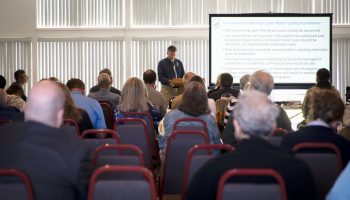This is the second part of a two-part conversation with new Chautauqua County Executive George Borrello, a veteran Republican county legislator from Silver Creek elected to his current office in November. In the conversation that ran Wednesday, June 27 in the Daily, Borrello talked about the county, its economy and its prospects, and his relationship with Chautauqua President Michael E. Hill and a potentially larger role for the Institution in the county.
In today’s conversation, Borrello turns his attention to the health and future of Chautauqua Lake, a subject that engaged unprecedented numbers of Chautauquans last summer after the New York State Department of Environmental Conservation gave permits for herbicides to be applied in limited areas of the lake as an experiment in weed control. The Institution takes its drinking water from the lake. The DEC granted permits for application of herbicides to a larger area in the lake earlier this month.
We continued our conversation in Borrello’s office in Mayville.
The introduction of herbicides into the north basin of the lake last June and again this month has Chautauquans alarmed. What are your thoughts and do you have a prescription for what ails the lake?
I’m not surprised we are talking about this. First, I want to say that Michael Hill and I have been in touch regularly on this question. We talk.
Secondly, and I’m prepared to say this on the record, the two main lake organizations on the herbicide question, the Chautauqua Lake Association and the Chautauqua Lake Partnership, are taking diametrically opposing positions on this issue. There is no common ground for them. I believe some common ground could be found, and that since everyone involved wants the best for Chautauqua Lake, that common ground needs to be found. We need to work together on this.
Chautauqua Lake is the only lake in New York state with a total ban on herbicides. There can be exceptions, via state Department of Environmental Conservation permits, as we have seen. I am well aware that there are some people who are simply diametrically opposed to the introduction of herbicides in the lake. I think, though, that many would say that if you can prove to me that it’s completely safe to use herbicides under strict controls and under tight DEC supervision and that there will be no harm to drinking water or the fish or the broader ecology, I’m willing to give it a try.
Our Chautauqua Lake is a eutrophic lake. That means it has naturally high levels of phosphorus and nitrogen. The lake is especially susceptible to plant growth nourished by, for example, phosphorus and nitrogen. Human activity continues to add these elements to the lake, which of course exacerbates the problem.
The county has focused mostly on treating the disease and not the symptoms. This arises partly from political considerations. If you try to make agriculture more lake-friendly or stabilize a remote rural stream bank to inhibit harmful erosion, there’s not much of a photo op there. Other activities, and I include in this both cutting the weeds and killing the weeds, are more visible and give taxpayers more easily accessible evidence of working on the lake problems. But while invasive weeds are undeniably a nuisance, algal blooms present a health risk.
Managing man-made flows into the lake is the solution. That aims to treat the voluminous plant growth in parts of the lake and to try to mitigate the disease of the harmful algal blooms that appear each summer. The county soil and water conservation district, and the Chautauqua Watershed Conservancy, with their land management policies, address this issue most directly.
We’re in a long-term struggle to save Chautauqua Lake here. There are short-term solutions that are Band-Aids, and I’m not saying they are not worthwhile. They can be. There are many considerations that are important, especially given the touristic appeal of the lake.
And we never lose sight of the fact that Chautauqua Lake is a significant economic driver for the county. Both the Institution and much residential development lies on the less-than 1 percent of county land mass inside the Rt. 394- 430 belt that surrounds the lake. But that tiny land mass provides over 25 percent of county property tax revenue.
There is science and there is politics on lake issues. What about the politics? There have been persistent rumors of political pressure as far up as Albany. Has the governor called you, for instance?
Not so far. That is a logical question, but remember that through the DEC, the state owns the lake. The county does not own the lake. Still, it is entirely within county borders. So there isn’t any direct county authority, but the lake is obviously a primary concern for county government.
I will say that the governor has announced a $65-million effort to study and hopefully solve or at least reduce the harmful algal bloom blight on New York lakes. Twelve of those 16,000 lakes were selected for special study, and Chautauqua Lake is one of them. So at least indirectly, the governor is involved in helping us. The county will manage the initiatives that will be funded through this grant process.
There is so much focus in the county on Chautauqua Lake. You live on Lake Erie.
Well, there are a lot of county businesses that depend on Lake Erie, and the county has generally paid less attention to Lake Erie. We did recently get money for dredging our three Lake Erie harbors, but it took us years to get it from the county and the state. No one but me is responsible for cleaning up my own Lake Erie shoreline, and I’ve got dead trees and weeds that wash up there.
Our county has 44 miles of Lake Erie shoreline, roughly what we have on Chautauqua Lake. About half of that is working farms or cliffs, but there are lots of places that afford public access to Lake Erie. There are fishing piers, free beaches and boat launches. So you have Lake Erie, with lots of public access and little public monetary support, and Chautauqua Lake, with little public access and lots of public money.
Nobody should misunderstand here. I clearly understand the importance of Chautauqua Lake to the county in so many ways. But this disparity is something to think about. It does provide a sense of perspective.
Let’s return to the science for a moment. Are we going to learn scientific truth on the lake?
Well, we see science manipulated for political purposes all the time. Look at climate change, for example.
Scientific research starts with a set of assumptions. We see that in every industry. As to Chautauqua Lake, we do have problems with weeds and algal blooms that also afflict many other bodies of water. Clear scientific solutions have proven to be elusive, especially on algal blooms.
We do need differentiated action plans for the north and south basins of the lake. In the north basin, we need to focus on agricultural runoff because that’s a bigger source of phosphorus loading in the lake. In the south basin, it’s more about internal plant loading.
I do think there may well be a responsible way to apply herbicides in the lake south of the bridge. We will need to be careful and move cautiously.
What’s your role as county executive in managing the lake?
I can be a facilitator. I’m not a scientist. In terms of taking action — applying herbicide, for example — you need to be a lead agency. There are two types of lead agencies here. One is the state, which owns the lake and manages it through the DEC. The other agency is the municipalities around the lake. In the case of the June 11 herbicide application, the lead agency was the town of Ellery, which includes the village of Bemus Point. The county cannot be the lead agency.
This lake business did not find me totally inexperienced. I had served previously as the chair of the Lake Erie Management Commission, and I have been heavily involved in watershed issues for Lake Erie.
So I can bring a bit of perspective to Chautauqua Lake issues, and also a bit of, shall we say, aggressive facilitation when necessary between conflicting organizations and points of view.
Again, I want to emphasize that we need to focus to a greater extent on treating the disease and not the symptoms. Killing and cutting the weeds is dealing with symptoms. And I have not seen evidence that herbicides address the health risk posed by the harmful algal blooms.
Can you explain the status of the county in the structure of state government?
Yes. In the eyes of the state, the county is just another municipality. We have no dominion over the other municipalities, such as towns and villages. I cannot, for example, call the town of Ellery and say ‘Stop something you are doing.’ The county does not control property assessment rates, zoning requirements, drainage, things like that. So I am a countywide elected official but have relatively limited countywide authority.
This example might help to give some perspective. In the village of Lakewood, the combined tax burden from county, town and village for property owners is around $40 per $1,000 of assessed value. The county gets exactly $8.44 of that. And of that $8.44, almost half goes to Medicaid.
Let’s touch quickly on sewering the lake.
We are making real financial headway on this. We have issues to resolve with the state comptroller over our county debt service requirements, but we’re moving. I’m pretty optimistic. Most of the affected area is actually on the west side of the lake, roughly northward from Stow. We have also instituted a policy where any property with a septic system within 250 feet of Chautauqua Lake would be subject to mandatory inspections by the county. Our inspections so far show that about 50 percent of those inspections fail. We will continue to do these inspections.
Again, when it comes to money, there is the countywide perspective. It’s not easy to tell someone in Westfield or Dunkirk that his or her taxes should go up to reduce nutrient flows into Chautauqua Lake, especially when some of the property owners along Chautauqua Lake have lawns that resemble golf courses and they do little to inhibit nutrient flows into the lake. We need property owners along the lake to do more.
I understand you are considering a study on the feasibility of creating a lake district for Chautauqua Lake.
Yes. The reason is simple. Creating a lake district would create a targeted source of revenue via a tax district. This device has been used successfully elsewhere and offers the advantage of directing local resources at local problems. I see it potentially as similar to a government-run homeowners association.
I want to emphasize that we are very early in this process. I’m organizing a Chautauqua Lake Agency Board as a temporary task force to look into the feasibility and usefulness of a potential lake district.
This board will look serve as a kind of consultant to me for this specific purpose. I’m thinking of membership including two town officials, two village officials, two legislators and perhaps one private property owner from around the lake. Michael Hill has agreed to serve on this board as well, representing Chautauqua Institution.
Again, it’s very early in the process. The board hasn’t even been formed. There will be a lot of additional information that comes out over the rest of this year and next, but nothing is imminent. I am thinking about this, though.
What surprised you most as you took office as county executive?
Not a lot, frankly. But one thing stood out. When I looked for low-hanging fruit from a budget savings perspective, I found a lot. The county is still running a structural deficit, and finding ways to balance the budget every year is a challenge. When I came into this job, I talked about finding ways to save money. Some county employees would say, ‘Well, there’s this one thing but it would only save $50,000.’
I subscribe to the theory of a bushel of pennies. A single penny may not add up to much by itself, but a bushel of pennies actually amounts to $332. So in the greater scheme of a $260 million annual county budget, $50,000 may not seem like much. But a bushel of such savings? It would go a long way to close our $5 million budget deficit.





